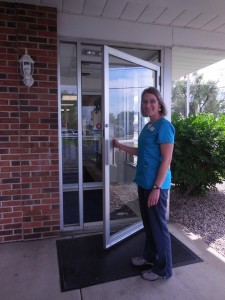New Wellness Blood Profiles
Now offering wellness blood panels. Make sure that your pet is happy and healthy with our new wellness blood profiles. Inquire today!!!
MoreNow offering wellness blood panels. Make sure that your pet is happy and healthy with our new wellness blood profiles. Inquire today!!!
MoreDr. Lisa Hatfield and Dr. Steve Case join the team at the Neenah veterinary clinic
NEENAH, Wis., June 30, 2015 — Two new veterinarians, Dr. Lisa Hatfield and Dr. Steve Case, are joining the medical team at American Animal Hospital in Neenah. Dr. Pat Mahoney, who has owned and operated American Animal Hospital for 36 years, is retiring. The clinic was purchased by Dr. J. S. Kaleka and his wife Kay, who officially assumed ownership on June 25, 2015.
 Dr. Lisa Hatfield will assume the role of Practice Manager and will also work full-time as a veterinarian. She provides veterinary services for cats, dogs, small mammals, reptiles and birds. She most recently worked at Hanover Park Animal Hospital in Hanover Park, Ill. and ran her own business, The Doctor Is In, offering veterinary relief services in Northern Illinois and Southeast Wisconsin. She is a 2007 graduate of Iowa State University College of Veterinary Medicine.
Dr. Lisa Hatfield will assume the role of Practice Manager and will also work full-time as a veterinarian. She provides veterinary services for cats, dogs, small mammals, reptiles and birds. She most recently worked at Hanover Park Animal Hospital in Hanover Park, Ill. and ran her own business, The Doctor Is In, offering veterinary relief services in Northern Illinois and Southeast Wisconsin. She is a 2007 graduate of Iowa State University College of Veterinary Medicine.
“We are thankful to Dr. Pat Mahoney for giving us this opportunity,” said Dr. Hatfield. “He has built a solid business with a wonderful clientele, and we admire the clinic’s reputation for high-quality veterinary care. We intend to continue to provide the highest quality care available in the Fox Cities for companion animals.”
 Dr. Steve Case most recently worked at Antioch Animal Hospital in Antioch, Ill. He will provide full-time veterinary services for dogs and cats, with special interest in dermatology and surgical care. He is a 2005 graduate of Iowa State University College of Veterinary Medicine.
Dr. Steve Case most recently worked at Antioch Animal Hospital in Antioch, Ill. He will provide full-time veterinary services for dogs and cats, with special interest in dermatology and surgical care. He is a 2005 graduate of Iowa State University College of Veterinary Medicine.
All current team members will continue working at the clinic. “We are keeping everything the same, and have prepared for the smoothest transition possible,” said Dr. Case. “We have a passionate, energetic team and look forward to working with them to continue to provide excellent veterinary services to our clients and their pets.”
“I am so grateful to have worked in this amazing community, caring for so many wonderful pets, for 36 years,” said Dr. Pat Mahoney. “My clients and teammates have become like family to me. I will miss everyone, but am confident the new doctors will continue to lead the clinic to provide the best services available.”
 Dr. J. S. Kaleka began practicing veterinary medicine in 1973. He and his wife Kay have previously owned and operated Germantown Veterinary Clinic (Germantown, Wis.), Schaumburg Veterinary Clinic (Schaumburg, Ill.), and Beaver Dam Veterinary Clinic (Beaver Dam, Wis.). They reside in Beaver Dam and will function as advisors to the American Animal Hospital team.
Dr. J. S. Kaleka began practicing veterinary medicine in 1973. He and his wife Kay have previously owned and operated Germantown Veterinary Clinic (Germantown, Wis.), Schaumburg Veterinary Clinic (Schaumburg, Ill.), and Beaver Dam Veterinary Clinic (Beaver Dam, Wis.). They reside in Beaver Dam and will function as advisors to the American Animal Hospital team.
American Animal Hospital (AAH), located at 1230 S. Commercial St. in Neenah, Wis., has been serving pet owners in the Fox Valley for more than 35 years. The clinic’s motto and promise to clients is to “care for your pets as if they were our own.” The team provides cat, dog, small mammal, reptile and bird exams, vaccinations, treatment and medication plans, diagnostics, spays and neuters, dental procedures an other veterinary surgeries, and emergency care. They also advise on pet behavior, nutrition, exercise and more. AAH is one of only two veterinary clinics in the Fox Valley to be AAHA (American Animal Hospital Association) Accredited, which means the clinic is evaluated on over 900 standards to ensure the highest quality of pet care. At AAH, pet parents can be assured of the highest quality of care available, and that every patient is a VIP. AAH is a proud supporter of community events and activities, as well as local animal rescues.
See full doctor bios and photos at: https://www.aahneenah.com/about-2/meet-the-team/.
##
MoreYou’ve heard it many times…it’s important to brush your cat’s teeth. But how many of us actually do this? It’s not an easy thing. However, it is very important, to ensure that your cat does not develop gum disease or tooth decay.
Dr. Pat Mahoney offers some easy tips on getting your cat used to the idea of having his or her mouth handled and teeth brushed. There are products that help you to effectively clean your cat’s teeth and he shows how to begin using them in this video.
Watch the video “How to Begin Brushing Your Cat’s Teeth” on our YouTube Channel here
By easing into the adjustment to having your cat’s teeth brushed, and then committing to doing it on a regular basis, you will be rewarded with a healthier cat who will live a longer, happier life~
MoreOften part of our 4th of July celebrations, fireworks can be terrifying and possibly painful for many of our dogs and cats.
Our pets have much more sensitive hearing as a survival advantage. The sharp concussion of a fireworks explosion may actually hurt them. They will often run and hide and tremble in response to the noise alone.
In addition, dogs and cats instinctively avoid smoke and fire. The gunpowder smell of expended firecrackers can trigger intense escape responses. This can lead to pets running away – in fact, the 4th of July is the number one day that pets get lost.
The bottom line: our 4th of July is just not fun for many pets!
What to do? Avoidance is #1 here. Don’t take your dogs to the fireworks show. Also don’t personally be the one firing off loud firecrackers near pet dogs or cats. When possible, keep the pets in the most sound-dampened room as you have during fireworks events. Turn on the TV or classical music.
Composure Pro is a nutrient product that can really help many patients. And the Thundershirt anxiety wrap is often very helpful. Both of these products use natural pathways to help reduce anxiety. See our Thunderstorm blog for a bit more information about these.
Medications may become part of the strategy to help some patients through this season. Rarely is the sedation side effect of Benadryl useful for these intense phobias. Alprazolam is the generic Xanax brand name. It truly is an anti-anxiety medication. Though this Rx makes the most medical sense, it just doesn’t help some dogs. Ace Promazine is a sedative and the old time prescription for this use. Many clients report that “Ace” works better for their pet. Some DVMs use both alprazolam and Ace together for some challenging cases.
Fireworks and thunderstorm fear is very real for many dogs and cats. Avoid the fireworks as much as you can. Prepare ahead for these events and try out Composure Pro or a Thundershirt BEFORE they are needed. Work with your veterinarian and help our furry companions through these frightening times.
More
 We are excited to announce that we are now open every second and fourth Saturday of each month, from 7:30am to noon!
We are excited to announce that we are now open every second and fourth Saturday of each month, from 7:30am to noon!
You can now schedule examinations for your cats and dogs during these weekend hours and receive vaccinations; advice on pet behavior, nutrition and exercise; treatment and medication plans; diagnostics; and other veterinary care as needed.
Appointments can be made by calling the clinic at 920-725-8522 during open hours, Mon/Tues/Thurs/Fri 7:30am-5:30pm, Wednesdays 7:30am-7:00pm, and every second and fourth Saturday 7:30am-noon. Pet owners may also make an appointment for their pet by e-mailing info@aahneenah.com.
In addition to offering Saturday hours, we offer cats-only hours and home-based veterinary services, all to provide more convenience for local pet owners.
 Offering extended service hours is another way the caring staff at American Animal Hospital brings the latest technologies and products to the local community that will help their pets live fuller, happier lives.
Offering extended service hours is another way the caring staff at American Animal Hospital brings the latest technologies and products to the local community that will help their pets live fuller, happier lives.
We look forward to seeing you and serving you soon!
MoreAnal glands are not something pet owners want to talk or think about, but they are something they need to know about.
Anal sacs, or glands, are located on both sides and slightly below your dog or cat’s anus. They produce fluid with a distinctive odor. Healthy anal glands express (empty) on their own when your pet has a bowel movement. However, some anal glands do not express on their own sometimes. This can be due to a variety of reasons, including inherited malformations, or poor-quality foods which can cause poor-quality bowel movements.
This can become a serious health issues for your dog or cat, because if those anal sacs do not empty properly on their own, they can become impacted. This can lead to difficult or painful bowel movements, which can lead to potential infections or abscesses.
The most obvious way your dog or cat will tell you that his or her anal glands are bothering him is that they will bite or lick at their anal area, or scoot across the floor in their own attempt to express the glands. The fluid in the anal sacs is extremely stinky, and you will know if your pet has expressed his or her anal glands on their own when you smell it.
If your pet is showing signs of being impacted, or if he or she has a history of it, it is best to have a professional express the anal glands for you. This can be done at some groomers, or at a veterinary clinic.
You can also ask your veterinarian to recommend a high-fiber diet to create stronger stools, which may lead to some relief. However, if that does not work and your dog or cat has repeated infections or abscesses, the anal glands may need to be removed.
See how anal glands are expressed by the certified veterinary technicians of American Animal Hospital in our How to Express Your Dog’s Anal Glands video here
More
Your pet means the world to you, and facing the decision on when it’s time to euthanize him or her is a very stressful, emotional time. There is no right answer to “when it is time” – but there are some guiding factors to help you make this difficult decision.
Dr. Melissa Heenan discusses this sad but important topic in the following video. She explains how when your decisions are made out of love, there really can be no wrong decision. When faced with whether or not to euthanize your pet, it is important to remain objective. She recommends determining your pet’s favorite 3-4 things to do, then creating a calendar to track if he or she is doing those things on a daily basis. These could be as simple as jumping on the couch, or running to fetch a ball, or using the litterbox. Monitoring your pet’s habits and activities closely will help you determine if they are still enjoying a quality of life.
She also discusses your options post euthanasia – burial, private or group cremation, and offers suggestions on mementos and other ways to memorialize your beloved pet.
Watch the full conversation with Dr. Melissa on the Video: How to Know When It’s Time – a Discussion on Pet Euthanasia here
Watch the video discussion with Dr. Melissa about Home Euthanasia: a Comforting Option for You and Your Pet here
More
It’s flea and tick season, and as always, it is critically important to protect your pet from them, as they can transmit deadly parasites and diseases to your cat or dog.
Vectra is a monthly topical preventative medication our clinic recommends for safe, effective protection. There are two versions, one for dogs, which protects against both fleas and ticks, and one is for cats, which protects against fleas. Please only use the appropriate one on your pets – applying the dog version on your cat can prove toxic to the cat.
Vectra comes with an easy-to-use applicator from which the pet owner simply squeezes the topical medication on to the back of their pet once a month. Your pet may get a “tingly” feeling after application, so it’s best to take them on a walk or play outside with them immediately following application, to get their mind off it.
Our veterinarians recommend Vectra because it is a safe, effective, virtually waterproof option that repels fleas and ticks before they attach to your pet. This product is available at our clinic at 1230 S. Commercial St. in Neenah, Wisconsin.
More
Keeping your dog’s ears clean is extremely important to ensure the health of your dog.
It’s best to check your dog’s ears weekly. Make sure there is no unusual redness or swelling, and that no fleas, ticks or mites have taken up residence.
If your dog is itching his or her ears, it is best to take your dog in to your veterinary professional to have his ears checked. This could be the result of a bacterial or yeast infection, or of fleas, ticks, mites or other risks associated with being outdoors, especially in the summer time. If this is the case, medical treatment is required, usually in the form of a topical treatment, or sometimes as an antibiotic injection or pill. Most of these cases are very easily treatable.
Fleas, ticks or mites are also easily preventable. We recommend a monthly topical preventative, such as Vectra or Sentinel, to protect your dog’s ears and overall health.
If your veterinary professional does find an infection in your dog’s ears, he or she will likely take a swab and look at the specimen under a microscope to determine if it is a bacterial or yeast infection. This will determine the most appropriate medical treatment.
Make sure if you do maintenance cleaning of your dog’s ears at home that you use an anti-fungal, anti-bacterial dog ear cleaner, available at your veterinarian, and clean your dog’s ears gently using cotton balls, not q-tips. Q-tips can cause more damage by poking the dog’s ear drum and possibly injuring it. Regular, gentle cleaning will decrease the chances of your dog developing a fungal or bacterial infection.
View our How to Properly Clean Your Dog’s Ears Video here
More
Trimming a dog’s nails properly is important for the safety and comfort of your canine companion.
Dog’s nails should be trimmed every 6-8 weeks. Without regular nail trims, dogs nails may grow too long and may fracture and break off, which can lead to infection, injury or other complications.
Depending on the size and breed of your dog, you may need assistance trimming his or her nails. Sometimes we recommend that only a professional trims a dog’s nails, for the owner’s safety and convenience.
If you are a beginner, it’s best to start by getting your dog used to having his or her paw’s handled. Try to touch his or her legs, feet and paw pads as often as possible to de-sensitive them to your touch. Do this as often as possible, not just at nail trim time.
When you are ready to trim your dog’s nails, you may want to solicit the help of a friend to hold your dog while you trim. You or your friend will need to hold your dog steady as the trimming is being done.
It is important to use a nail trimmer made specifically for trimming dog nails. These are available at most pet supply stores, groomers or veterinary clinics.
You will extend your dog’s nails and trim off only the tip of the nail. Dog nails come in all different colors, so be extra careful with dark-colored nails. Inside the nail, toward the bottom by the nail bed/paw pad, is what is called the “quick.” This is blood inside the nail.
You want to trim your dog’s nails above the quick. If you accidentally hit the quick, the dog’s nail will bleed. You will then need to put styptic powder, cornstarch or flour on the dog’s nail to stop the bleeding. Your dog will not bleed to death, but it is a good idea to have these powders on hand in case you nick a nail.
With practice, trimming your dog’s nails becomes an easy, quick routine. If you are unsure about it, your veterinarian or groomer are willing to trim your dog’s nails for you.
Watch our How to Trim Your Dog’s Nails video here
More